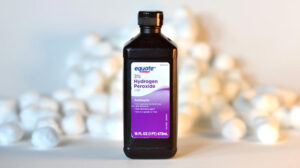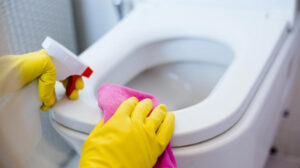MAY 26, 2023

Clean white toilet with open lid. – Rawf8/Getty Images
Yikes! Unexpected guests are on the way and you only have 30 minutes to do damage control in the bathroom. No toilet bowl cleaner left? No problem. Simply open the medicine cabinet and grab a bottle of hydrogen peroxide. The colorless liquid is known for sterilizing scrapes, but did you know it can do the same for smelly toilet bowls? When you pour hydrogen peroxide into your toilet get ready to hear angels sing as the chemical’s germ-fighting features effortlessly remove dirt, grime, bacteria, and the gross stuff that’s really causing your toilet bowl stains.
No need for industrial-strength antiseptic; the familiar brown bottle of 3% hydrogen peroxide is all that’s required to give your toilet bowl a deep clean. The percentage marking on the container’s label indicates the strength. Common medical-grade hydrogen peroxide is 97% water and 3% peroxide. When you break it down, hydrogen peroxide is simply water with an extra oxygen atom. However, it’s that bonus atom that gives hydrogen peroxide its super cleaning power: oxidation. The chemical reaction kills bacteria, yet is safe to use around humans and pets.
How To Clean Toilets With Hydrogen Peroxide

Bottle of hydrogen peroxide. – Jesse Franks/Shutterstock
To clean your toilet bowl with hydrogen peroxide, measure out half a cup, pour it directly into the bowl, let sit for 20 minutes, scrub the bowl and under the rims with a toilet brush, then flush. For tough stains, add peroxide to the bowl targeting smears and splatters, scrub with a brush, let sit for 30 minutes, then flush. You can also use hydrogen peroxide to clean your toilet seat and lid by soaking a rag with the antiseptic and gently wiping away spots or smudges. If you notice brown stains, limescale, or other unsightly mineral deposit buildup in your bowl, pour about a cup of hydrogen peroxide directly into your toilet tank. The chemical’s bleaching properties will dissolve stains and sanitize the tank without damaging the flapper or flush valve.
To make cleaning even easier, hydrogen peroxide can be purchased in a spray bottle or you can simply buy a traditional capped container of the liquid and transfer it into your own recyclable spray bottle. Depending on the size of your toilet bowl, spritzing hydrogen peroxide may be more advantageous than pouring as the spray nozzle allows for more even distribution and is able to saturate hard-to-reach nooks and crannies. Moreover, when you are done scrubbing your bowl, you can quickly and easily spray hydrogen peroxide on your toilet brush prior to storing it so it will be bacteria-free when you are ready to use it again.
Pros And Cons Of Cleaning With Hydrogen Peroxide

Cleaning toilet with spray bottle. – Djedzura/Getty Images
Disinfecting toilets may be a surprising way to use hydrogen peroxide in your home, but if you consider that many popular brands of toilet bowl cleaner list it as an active ingredient it makes perfect sense to use the unadulterated version. What’s more, doing so will save you a ton of cash given that a standard 32-ounce bottle of 3% hydrogen peroxide costs less than $2 while brand-name toilet bowl cleaners sell for nearly double. Price comparisons to bleach may be a bit more comparable, but hydrogen peroxide won’t make your bathroom smell like a swimming pool. The non-toxic liquid is odor-free yet brightens and whitens just like bleach. Still, inhaling excessive amounts of hydrogen peroxide is not healthy, so make sure you are cleaning in a well-ventilated space and consider wearing gloves if you have sensitive skin.
Finally, before you move hydrogen peroxide from the medicine cabinet to the cleaning closet, check the expiration date. The chemical antiseptic starts decomposing from its first use, and over time, it will lose its disinfecting powers. Once all of the oxygen breaks down you will be left with little more than a bottle of plain water. To slow down the decomposition process keep hydrogen peroxide away from direct sunlight. Your best bet is to store it in its original brown bottle or a dark-colored container in a cool shady spot.
Courtesy/Source: House Digest































































































